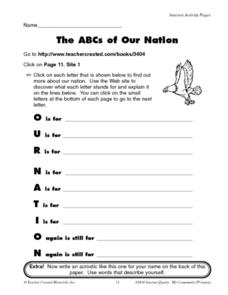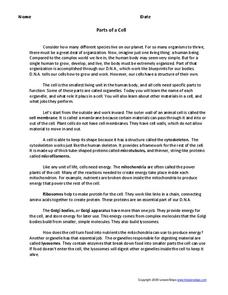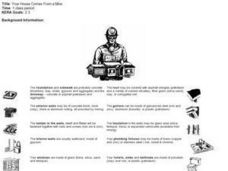Curated OER
Funny Ears
Young scientists get a worksheet that has a picture of a dog, a donkey, a person, a mouse, a rabbit, and a cat. Each picture has the wrong ears attached to it! Learners must draw lines matching up the ears with the correct recipient. The...
Curated OER
Loud or soft?
Send this cute activity home with kids, to increase family involvement. They'll consider what would happen if rice was bounced in a tambourine, and then they'll complete a sound activity by makings an instrument out of wax paper and a...
Curated OER
Soil Porosity, Moisture Content, pH, and Density
This lab activity does not have to be done with AP environmental scientists. It can also be done with middle to high school earth scientists. The procedures aren't complex. Learners determine the density of dry and wet sand in order to...
National Center for Case Study Teaching in Science
To Boldly Go, or Not
Here is a different way to combine social studies and science. Have your high schoolers read a passage about the 2004 vision for space exploration and then discuss the practicality, costs, and reasons for returning to the moon. Then, the...
Curated OER
The good microbes
The question posed for the class to consider; What would decay and what would not? They read the short passage on decomposition and microbes, then mark the items that would decay after a two-week period. A scientific investigation idea...
Curated OER
The ABCs of Our Nation
In this social studies instructional activity, students are directed to a Web site to find out what makes our Nation special. Students create an acrostic poem about our country. Students then explore the need for responsible living...
Parkway Schools
Phase Changes and Heat
In this phase changes learning exercise, students use the specific heats for different substances to determine how much heat is needed for those substance to change phases. This learning exercise has 9 problems to solve.
Curated OER
Trees Are More Than Wood
In the science and art instructional activity, students think about and draw the shape of a tree. They explain if all trees look the same before accessing a web site to read about the shapes of trees. They write down three things that...
Curated OER
Parts of a Cell
Simplify the parts of a cell with this handout and brief activity. Learners read a two-page explanation of the parts of a cell that includes bolded vocabulary words. Using what they have just read, class members answer 19...
Curated OER
4-H Dairy Activity Page; Ethical Decision Making
Get your 4-H farmers ready for their dairy project with this activity page, which focuses on helping students form ethical decisions. A variety of activities, including a scavenger hunt, a word search and viewing the anatomy of a dairy...
Curated OER
Jellyfish
In this jellyfish worksheet, learners read one paragraph about jellyfish and then complete fill in the blank sentences about what they read. Students complete 4 sentences.
Curated OER
History of Physics
In this history worksheet, students use the questions to discover meaningful science and history connections. The worksheet is meant to be viewed online to access individual answers.
Curated OER
Sliding Mass Problems
Physics masters solve five sliding mass problems. For each, there are a few different values to be determined: normal force, force of friction, acceleration, velocity, coefficient of friction, or net force. Pupils must draw a force...
Curated OER
Life in the Freezer
In this global warming worksheet, climatologists examine a few possible results of climate change. There is no specific reading from which learners extrapolate the information needed to answer the questions, so you will need to preface...
Curated OER
Facts on Fish Species
Here is a brief outline of facts on various Chesapeake Bay fish species. Use it as an example of what kind of information you want your life science learners to collect when you assign them a specific species to research. Another way to...
Curated OER
Intermolecular Forces
In this intermolecular forces worksheet, students read about the two types of forces: dispersion forces and dipole-dipole forces. Students then complete 2 problems based on what they read.
Curated OER
Unit 0 Review - Measurement Lab Equipment
Review questions like these can be used in your biology, chemistry, physics, or earth science classes! They assess scientists' understanding of laboratory measurement tools including graduated cylinders, thermometers, and balances. They...
Curated OER
How Substances Get in and out of Cells
Although it contains some formatting issues, the Word document here contains good questions about osmosis and diffusion, and is easy to edit as needed. Designed as a study guide, you could use the information here for warmups, ideas for...
Curated OER
Fall 2004 Midterm Exam #1, Parts A & B
First year physics learners show what they know about electric potential, circuits, power, current, and voltage on this midterm exam. It consists of a multiple choice section, some true or false questions, and two multi-step problems to...
Institute for Systems Biology
Introduction to Saline Environments & Microbial Halophiles
If you do not mind wading through unrelated headings (This is not for a physics or STEM course, as it states.) and content (The lesson opens with an article about neurology, not halophiles.), then you will find a valuable resource on...
Curated OER
Hairy Evidence! Hair Identification
Provide a mystery hair and a set of reference hair samples for middle school investigators to place on a slide and examine under a microscope. Materials and procedures are detailed on the first page, while a data table for drawing what...
Curated OER
Photosynthesis: An Overview
This photosynthesis quiz containing multiple-choice and short-answer questions challenges young biologists to extend their thinking beyond knowledge recall. There is one question referring to a certain page in the unidentified textbook,...
Curated OER
Your House Comes from a Mine
What do your learners know about mining? Invite them to read about all of the materials that come from mining that go into building a house. Additionally, they answer four questions at the bottom of the activity.
Curated OER
ABO Blood Types Worksheet
Blood types and transfusions are explained in reading passages at the top of the worksheet. A chart of blood type compatibility is also provided. Biology students answer comprehension questions and then exercise critical-thinking skills...
Other popular searches
- What Is Science Important
- What Is Science Worksheets
- Science What Is Science
- What Is Science Fiction
- What Is Science Worhsheets
- What Is a Science Theory
- What Is Science Skills?
- What Is Science Florida
- Science What Is a Rock?























